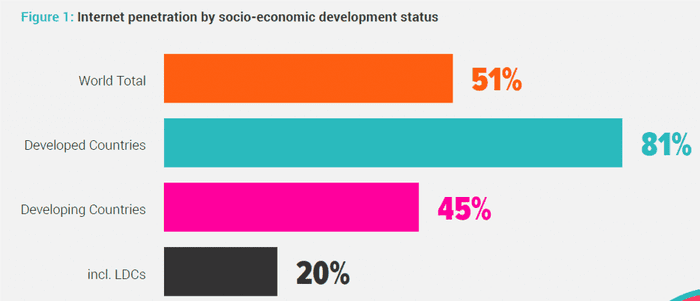Low internet penetration is particularly acute in the developing countries. While 81% of the population in the developed world are already using the internet, only 45% in the developing countries can do so.
November 14, 2019

According to data published by the International Telecoms Union (ITU), the United Nations agency overseeing the telecoms industry, 3.9 billion people, or 51.2% of the world’s total population, were already connected to the internet by the end of 2018. While the 50% mark was hit half a year earlier than the agency’s previous estimate, it nevertheless means that half of the world’s population remains unconnected.
Here we are sharing the opening section of this Telecoms.com Intelligence special briefing to look at the status of the unconnected and under-connected parts of the world and explores how the industry as well as the public sector can overcome the challenges to bring internet to the half of the world yet to be connected.
The full version of the report is available for free to download here.
Introduction: why half of the world is still unconnected
The low internet penetration is particularly acute in the developing countries. While 81% of the population in the developed world are already using the internet, only 45% in the developing countries can do so. Among them, less than 20% of the population in the 47 least developed countries, defined as “low-income countries that are suffering from long-term impediments to growth”, enjoy this luxury.

Source: ITU
There are three leading factors at play to leave a large part of the world off the grid. The first two are interlinked one way or another, the third is out of the telecoms industry’s remit. The most obvious one is pure economics. Diminishing marginal return or increasing marginal cost, often both at the same time, means operators will be less and less motivated to connect the next subscriber than the last. This could be down to the distribution of population. The more sparsely populated the location is, the less rewarding for the operators to reach them it becomes, because, even if the returns are assumed to be equal, the cost will be higher. This could also be related to the socio-economic status of the people. The less well-off the population is, the less attractive it becomes for operators to make the effort, because, even if the cost could be assumed equal, the return would be lower.
There are also technology barriers. Unfriendly terrains, for example mountainous areas, prove extremely challenging for operators to overcome. Related to the economic factors, these areas are also typically not the most densely populated. Satellite communication could be used as an emergency solution but would be too costly to use as regular internet access mode, or for operators to provide it if there is not a sizeable user base especially business users.
In some cases, the hurdle is simply too high for telecoms alone to clear. High internet penetration in North Korea is highly unlikely to happen in the near future without a fundamental change to the country itself, for example.
With these considerations in mind, this report will address the first two factors affecting internet penetration: economic and technology. Specifically, it will attempt to provide answers to these questions:
On the supply side, what technology solutions have been made available to drive down the cost level, therefore to make connecting the unconnected more appealing to telecom operators? What are still debatable or being desired? What business case do they present to operators?
On the demand side, what factors need to be in place for the unconnected population to be able to afford the connection, and to be willing to embrace it? And what are the factors beyond cost that may also drive the demand?
——————————-
The rest of this briefing includes sections on:
Supply side solutions: OpenRAN, TIP, and all that
The drivers for demand: affordability and more
What else should be in place?
An interview with Thecla Mbongue, Senior Analyst, Ovum
To access the full briefing please click here
Read more about:
DiscussionAbout the Author(s)
You May Also Like








.png?width=300&auto=webp&quality=80&disable=upscale)


_1.jpg?width=300&auto=webp&quality=80&disable=upscale)


.png?width=800&auto=webp&quality=80&disable=upscale)